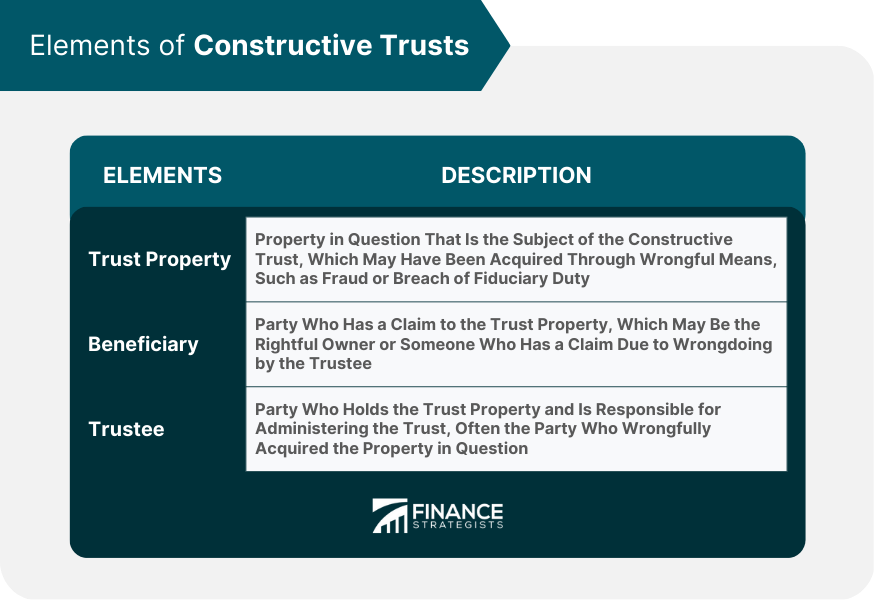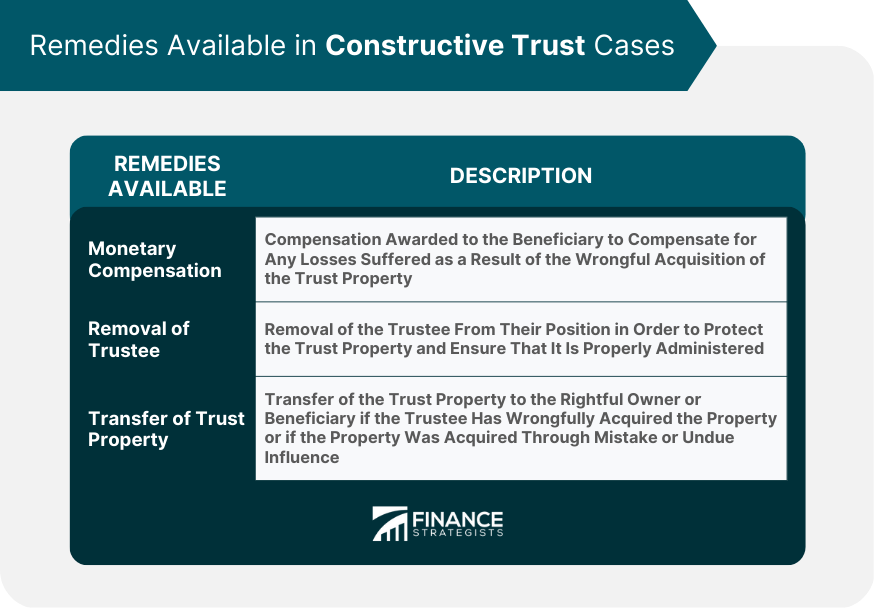A constructive trust is a legal concept that arises in situations where one party holds property that rightfully belongs to another. In essence, a constructive trust is a legal device or type of trust used to impose a trust relationship on the property where no formal trust agreement exists. The purpose of constructive trusts is to prevent one party from unjustly benefiting from property that they acquired through wrongdoing or by mistake. Constructive trusts arise from legal claims such as fraud, misrepresentation, undue influence, mistake, or breach of fiduciary duty. When one party acquires property through any of these wrongful means, a constructive trust may be imposed by a court to remedy the situation. The concept of a constructive trust is distinct from express trusts, which are created by a formal agreement between a settlor, a trustee, and a beneficiary. In contrast, constructive trusts arise by operation of law, regardless of the intentions or expectations of the parties involved. Constructive trusts can arise in a variety of contexts, such as real estate, intellectual property, and personal property. The legal basis for constructive trusts is derived from equity, which seeks to prevent unjust enrichment and ensure fairness in legal relationships. Constructive trusts are a form of equitable remedy that allows courts to impose a trust relationship on the property to prevent unjust enrichment. To establish constructive trust, certain elements must be present. These elements include the trust property, the beneficiary, and the trustee. The trust property is the property in question that is the subject of the constructive trust. This property may have been acquired through wrongful means, such as fraud or breach of fiduciary duty. In some cases, the trust property may be commingled with other property, making it difficult to identify and trace. The beneficiary is the party who has a claim to the trust property. This may be the rightful owner of the property or someone who has a claim to the property due to wrongdoing by the trustee. The beneficiary of a constructive trust may be an individual, a group of individuals, or an organization. The trustee is the party who holds the trust property and is responsible for administering the trust. In the case of a constructive trust, the trustee is often the party who wrongfully acquired the property in question. The trustee has a fiduciary duty to act in the best interests of the beneficiary and to ensure that the trust property is protected and preserved. There have been many high-profile cases in which constructive trusts have been imposed. One such case is the case of Twinsectra v Yardley, which involved a claim for dishonest assistance in the misappropriation of funds by a bank employee. The court imposed a constructive trust on the funds in question, as the bank employee had acquired the funds through wrongful means. Another example of a case involving constructive trust is the case of Sinclair Investments v Versailles Trade Finance Ltd, which involved a claim for breach of fiduciary duty by a company director. The court imposed a constructive trust on the profits made by the company director, as he had breached his fiduciary duty by using company funds for personal gain. When a constructive trust is established, there are several remedies that may be available to the parties involved. These remedies include monetary compensation, removal of the trustee, and transfer of the trust property. Monetary compensation may be awarded to the beneficiary to compensate for any losses suffered as a result of the wrongful acquisition of the trust property. The amount of compensation awarded will depend on the specific circumstances of the case and the extent of the wrongdoing. In some cases, it may be necessary to remove the trustee from their position in order to protect the trust property and ensure that it is properly administered. This may be necessary if the trustee has breached their fiduciary duty or acted in a manner that is detrimental to the interests of the beneficiary. In other cases, it may be appropriate to transfer the trust property to the rightful owner or beneficiary. This may be necessary if the trustee has wrongfully acquired the property or if the property was acquired through mistake or undue influence. Constructive trusts can also play an important role in estate planning. A constructive trust may be used to ensure that property is distributed according to the wishes of the deceased or to prevent certain individuals from benefiting from the estate. One example of the use of constructive trusts in estate planning is in cases where a testator has promised to leave property to a particular beneficiary but then fails to include that beneficiary in their will or trust. In such cases, the courts may impose a constructive trust on the property to ensure that it is distributed to the intended beneficiary. Another example of the use of constructive trusts in estate planning is in cases where a person wishes to disinherit a particular individual but is unable to do so because of legal restrictions. For example, in some jurisdictions, a testator may be required to provide for their spouse or children in their will, even if they do not wish to do so. In such cases, a constructive trust may be used to ensure that the property is distributed in accordance with the testator's wishes. One of the main benefits of incorporating constructive trusts in estate planning is that they provide a way to ensure that property is distributed according to the wishes of the testator. This can be particularly important in cases where there are complex family dynamics, or where the testator wishes to exclude certain individuals from their estate. However, there are also risks associated with incorporating constructive trusts in estate planning. One risk is that the use of a constructive trust may be challenged in court, leading to costly and time-consuming litigation. Additionally, the use of constructive trust may be seen as an attempt to circumvent the normal rules of inheritance, which may not be viewed favorably by the courts. Constructive trusts are an important legal concept that arises in situations where one party holds property that rightfully belongs to another. Constructive trusts are a form of equitable remedy that seeks to prevent unjust enrichment and ensure fairness in legal relationships. To establish a constructive trust, certain elements must be present, including the trust property, the beneficiary, and the trustee. When a constructive trust is established, there are several remedies that may be available, including monetary compensation, removal of the trustee, and transfer of the trust property. Constructive trusts can also play an important role in estate planning, providing a way to ensure that property is distributed according to the wishes of the testator. However, there are also risks associated with incorporating constructive trusts in estate planning, including the risk of litigation and the possibility of the trust being challenged in court. Legal professionals and experts in estate planning should be familiar with the key characteristics, legal basis, elements, remedies, and case examples of constructive trusts in order to provide effective advice to their clients.What Is a Constructive Trust?
Legal Basis for Constructive Trusts
Elements of Constructive Trusts

Trust Property
Beneficiary
Trustee
Case Examples of Constructive Trusts
Remedies Available in Constructive Trust Cases

Constructive Trusts in Estate Planning
Benefits and Risks of Incorporating Constructive Trusts in Estate Planning
Final Thoughts
Constructive Trust FAQs
A constructive trust is a legal concept used to impose a trust relationship on property where no formal trust agreement exists, typically arising in situations where one party holds property that rightfully belongs to another.
Constructive trusts arise from legal claims such as fraud, misrepresentation, undue influence, mistake, or breach of fiduciary duty, and are based on equity principles that seek to prevent unjust enrichment and ensure fairness in legal relationships.
The elements of a constructive trust include the trust property, which is the property in question that is the subject of the constructive trust; the beneficiary, which is the party who has a claim to the trust property; and the trustee, which is the party who holds the trust property and is responsible for administering the trust.
The remedies available in constructive trust cases include monetary compensation to the beneficiary, removal of the trustee, and transfer of the trust property to the rightful owner or beneficiary.
Constructive trusts can be used in estate planning to ensure that property is distributed according to the wishes of the testator, particularly in cases where there are complex family dynamics or where the testator wishes to exclude certain individuals from their estate.
True Tamplin is a published author, public speaker, CEO of UpDigital, and founder of Finance Strategists.
True is a Certified Educator in Personal Finance (CEPF®), author of The Handy Financial Ratios Guide, a member of the Society for Advancing Business Editing and Writing, contributes to his financial education site, Finance Strategists, and has spoken to various financial communities such as the CFA Institute, as well as university students like his Alma mater, Biola University, where he received a bachelor of science in business and data analytics.
To learn more about True, visit his personal website or view his author profiles on Amazon, Nasdaq and Forbes.















